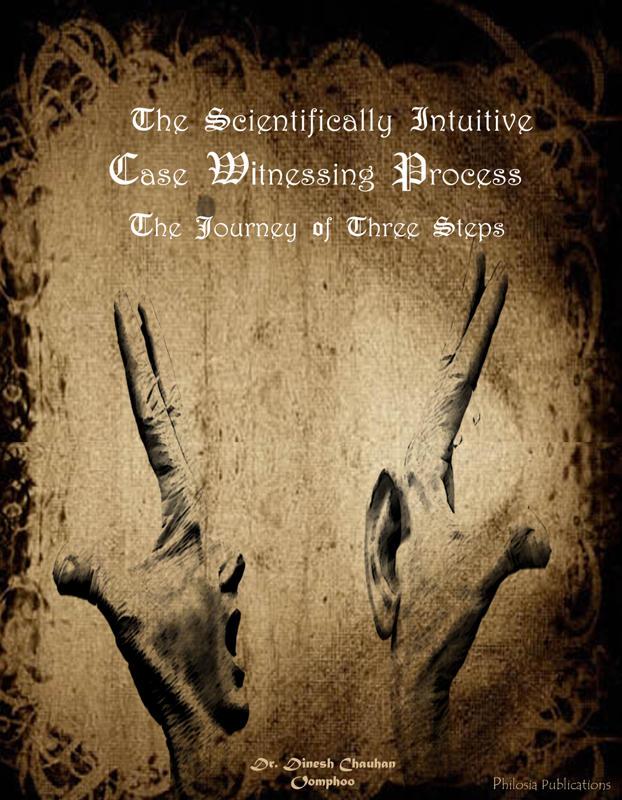Passive Case Witnessing Process (PCWP)
Active Case Witnessing Process (ACWP)
Active-Active Case Witnessing Process (AACWP)
PCWP: The 1st Sensitive Step
Clearing the conscious rattle; bringing forth the spontaneous outpouring of the subconscious.
Homeopath is passive & alert.
This step aids to predict all the aspect of further case.
• Tell more about you … A bit more … Just go on …
• My whole aim is to understand you. Be spontaneous.
• Go deep within yourself and talk about whatevere comes up.
ACWP: Transition phase
Making the journey from the conscious self to the subconscious and beyond.
Homoeopath moves from multi- to uni-dimensional listening.
• Out of all this, what bothers you the most?
• Deep within, how does it feel?
• Be with this focus and see what else is coming up.
AACWP: The Grand Finale
The homoeopath zooms in on the focus, and he himself is extremely focused and active.
All the isolated, scattered verbal and nonverbal expressions that spilled out during the Passive and Active stages are connected in one phenomenon.
• Describe the focus. Just concentrate on the “what” of the focus and cut out everything which has to do with the “why”, “where”, “how”, “who”, “maybe”, “could be”, or “should be”.
• Describe the whole process / phenomena / pattern.
• Describe the complete phenomena with a hand gesture.
Aims of Passive Case Witnessing Process (PCWP)
1. To pay attention to all the verbal and nonverbal expressions that are out of place, out of order, out of flow, out of content, out of proportion, out of your knowledge, out of the patient’s knowledge, and out of any time zone
2. To find the focus of the patient
3. To find out the patient’s Level of Experience (LOE)(Name, Fact, Emotion / Feeling, Delusion, Sensation, Energy)
4. To know how the patient is expressing his level of experience. E.g. in touch with himself, Denying, Projecting, Avoiding or Rationalising, etc.)
Questions we ask to patient during Passive phase
1. Tell more about you… A bit more… Just go on…
2. My whole aim is to understand you. Be spontaneous.
3. I didn’t understand anything.
4. Anything else about you?
5. What else is bothering you?
6. Keep talking about it.
7. Go with the flow.
8. We don’t want anything specific. Just speak whatever is coming up in this given moment of time.
9. Everything you speak is significant.
10. Be spontaneous and keep talking.
Aims of the Active Case Witnessing Process (ACWP)
To explore fears
Tell some of your fears.
Describe those fears as completely as possible. Can you give me two or three examples?
To explore dreams
What dreams do you have at night?
Describe one or two dreams which you’ve had recurrently since childhood until today.
Out of all those dreams, which one had a deep impact on you?
Then,
Which part of the dream is most striking to you?
Similarly, we can explore the other areas, such as imagination / phobias / fantasies / interests and hobbies, and we can try and attain the patient’s focus (as explained in the first aim of the ACWP).
b] If a patient is talking about many situations, yet we don’t get a significant focus, then the following questions can help us find the focus:
• What do you feel in all the situations that you are in?
• What does this situation feel like? What do these situations feel like?
• How does it feel to have this problem? How does it feel to have these problems?
• What do you experience within yourself in this situation? What do you experience within yourself in all these situations?
• What is the effect of this on you?
• More
*3 ACWP: Once the focus is clear and confirmed during the ACWP, we proceed further in exploring the focus until the patient moves from local to general and vital
We keep in mind the following to frame a question:
a] WHAT is the LOE of the patient?
b] How are the LOEs being expressed? (Is the patient in touch with himself or has he denied / projected / avoided / rationalised, etc., etc.)
a] If the patient expresses his level of experience while being in touch with himself, the following promptings can be used:
Level of Experience
Name and Fact
Feeling
Delusion
Sensation
Promptings and questions
Describe this focus a little bit more so that I can understand.
I didn’t understand, means what?
Can you summarise that again for me?
Allow your thoughts to move and see what else is coming up with this focus.
Deep within, how does it feel?
Talk about this focus in general, not related to you.
What is the feeling in this focus?
Be with this focus and see what else is coming up.
Be as imaginative as possible.
With this (focus), it feels as if …
Give a few examples of it to help me understand.
Allow your imagination to run and see what else you perceive with this focus.
Give one or two imaginary examples of this.
Do not go by logical thinking. I am just trying to understand your imagination.
Describe this focus as completely as possible.
What is the experience with this focus?
I understood where, why, with whom it happens. Now just see what happens in this.
What bodily sensation do you experience in this focus?
Any peculiar hand gestures associated with this focus (or otherwise) can be asked about at this juncture.
b] When in Denial, Projection, Avoidance, Rationalisation, etc., etc. if the patient is at the level of sensation, the questions are framed as follows:
Type of Defence
Projection
Avoidance
Denial
Rationalisation
Expression
He feels caught
I avoid situations where I feel caught
I never feel caught
The feeling of being caught arises because, when I am running, I … (getting into rationalisation)
Questions asked
How will that person experience it?
What is the experience in such situations?
What does one experience in those situations?
Can you just talk about “feeling caught”, leaving every other detail aside?
Active-Active Case Witnessing Process
Three stages of the AACWP
1] A Radical View
(Mandatory stage, all patients travel this journey)
2]* An Expanded View
(Discretionary, its possibilities differ from patient to patient)
3]* A Journey of Awareness
(Discretionary, its possibilities differ from patient to patient)
Journey from …
From the Focus to the Complete Altered Pattern.
From the Complete Pattern until the Source
From the Complete Pattern to Healing Awareness
Aims
-To elicit the complete altered pattern / phenomenon / process
-To understand the kingdom, subkingdom, family
-To understand the miasm
-To understand the reaction
-To grasp the scientific completion of the case
-To confirm the simillimum
-To self-question (at the end)
a]To elicit the complete natural language of the source
b]*To ensure the surety of the source being correct
c]To be aware of subtle indications when the patient reaches the right source
-To make the patient experience his sensation until awareness.
-To allow the patient to experience the healing awareness until his projection becomes awareness, and until his denial becomes awareness.
Questions that helps at this phase are:
• Describe the focus. Just concentrate on the “what” of the focus and cut out everything which has to do with the “why”, “where”, “how”, “who”, “maybe”, “could be”, or “should be”.
• Describe the whole process / phenomena / pattern.
• Describe the complete phenomena with a hand gesture. (This is the right place to inquire about hand gestures.).
• Describe the whole phenomena as completely and vividly as possible.
• Many more questions and promptings are formed according to the individual patient’s level of experience and at what level is that expressed. More...
 THE SCIENTIFICALLY INTUITIVE CASE WITNESSING PROCESS: A JOURNEY OF THREE STEPS
THE SCIENTIFICALLY INTUITIVE CASE WITNESSING PROCESS: A JOURNEY OF THREE STEPS
Authors: Dr. Dinesh Chauhan and Oomphoo
Published by: Philosia Publication (Dr.Urvi Chauhan)
Pages: 305 Hardbound
Book Reviews
![]() Homeopathic world community (HWC) : Reviewed by Debra Bruck (Director of Homeopathic world community)
Homeopathic world community (HWC) : Reviewed by Debra Bruck (Director of Homeopathic world community)![]() Interhomoeopathy: Online Homeopathic Journal: Editor and Reviewed by Deborah Collins
Interhomoeopathy: Online Homeopathic Journal: Editor and Reviewed by Deborah Collins![]() Review by Rebecca Williams
Review by Rebecca Williams ![]() Review by Kaare Troelson
Review by Kaare Troelson![]() Review About the book and author by Dr. Sameer Thakkar (M.D. Hom)
Review About the book and author by Dr. Sameer Thakkar (M.D. Hom)
About the book
One of the biggest achievements for a homoeopathic doctor is reaching a comprehensive understanding of his patients so that he can find a simillimum for them. And this is where the importance of case-taking comes in. Dr. Dinesh's scientifically intuitive case witnessing process (a uniquely designed case taking model) helps a homoeopath reach the deepest core of the patient with relative ease. The entire process is completely scientific, human-centric, simple, and reproducible. Furthermore, anyone, be that a traditional classical homoeopath or a contemporary classical homoeopath, can make use of the CWP with ease and success.
In this book, you will find (with case examples):
- Exploration of the connecting thread that runs through the myriad of homeopathic approaches , ranging from the traditional Hahnemannian approach to the contemporary classical era; ultimately, Dr.Chauhan unites them in a comprehensive vision
- The A to Z of the Case Witnessing Process (CWP): Introduction, importance, aims and objectives
- The Three fundamental Steps of the CWP: Passive, Active, and Active-Active CWP (Importance, Application, as well as pointers for progressing from steps 1-3)
- Possible obstructions one may face, and the appropriate techniques of case taking, such as Denial, Projection, Dissociation, Internal witnessing, etc., etc., to tackle such obstructions in a case and pointers that help one know WHICH technique to use WHEN
- A study of WHEN, HOW and WHAThealing awareness takes place in the patient during the case interview
- A path-breaking concept: “Healing the Healer”. The therapeutic effect of the CWP on the healer
- Numerous sketches of hand gestures made by patients, drawings that bring to life the illustrative cases presented in the book

The X-Factors of the Book: OOMPHOO
Oomphoo is a delightful new element in this book. Co-author of this book, Oomphoo is a comic character who is the reader’s friend, as well as a commentator on--and critic of--Dinesh’s work. Oomphoo makes comments throughout the book. His remarks are designed to prompt the reader to think more deeply about the points being explored by Dr. Chauhan and to do so in the context of joy and laughter.
![]() HOW OOMPHOO CAME INTO EXISTANCE
HOW OOMPHOO CAME INTO EXISTANCE
This book is not mere add-on theory to existing books on homoeopathy; rather, it is the result of Dr. Chauhan's quest to understand the nature of human beings in their completeness. Dr Chauhan has made the case witnessing method accesible to anyone who wishes to effect a cure in the central disturbance of a patient. Reading this book will surely give every reader the feeling, "I can do it!"
Book on Facebook
facebook.com/dr.chauhan.philosia.publication


